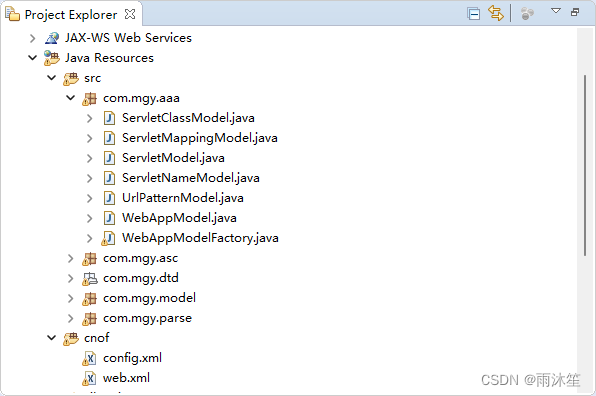目录
前言
今天分享的是J2EE中的建模,希望对各位有所帮助
提示:以下是本篇文章正文内容,下面案例可供参考
一、建模
1)适用于什么时候:
当重复性的代码较多,对同一个xml文件需要重复的解析时,我们就要用到建模
2)建模原理:
以面向对象的思想操作xml文件
3)案例:
①将每一个标签当成一个对象,并且分析每一个对象的行为和属性,即建包处理
<?xml version="1.0" encoding="UTF-8"?>
<!-- config标签:可以包含0~N个action标签 -->
<config>
<!-- action标签:可以饱含0~N个forward标签 path:以/开头的字符串,并且值必须唯一 非空 type:字符串,非空 -->
<action path="/regAction" type="test.RegAction">
<!-- forward标签:没有子标签; name:字符串,同一action标签下的forward标签name值不能相同 ; path:以/开头的字符串
redirect:只能是false|true,允许空,默认值为false -->
<forward name="failed" path="/reg.jsp" redirect="false" />
<forward name="success" path="/login.jsp" redirect="true" />
</action>
<action path="/loginAction" type="test.LoginAction">
<forward name="failed" path="/login.jsp" redirect="false" />
<forward name="success" path="/main.jsp" redirect="true" />
</action>
</config>action建模:
package com.mgy.model;
import java.util.HashMap;
import java.util.Map;
/**
* 对应action标签
* @author Administrator
*
*/
public class ActionModel {
// <action path="/loginAction" type="test.action.LoginAction">
private String path;
private String type;
private Map<String, ForwardModel> fMap=new HashMap<String, ForwardModel>();
public String getPath() {
return path;
}
public void setPath(String path) {
this.path = path;
}
public String getType() {
return type;
}
public void setType(String type) {
this.type = type;
}
//两个行为,增加forwardModel对象,查找forwardModel对象
// 将一个新的forward标签对象加入容器
public void push(ForwardModel forModel) {
fMap.put(forModel.getName(), forModel);
}
public ForwardModel pop(String name) {
return fMap.get(name);
}
}
action中实例化map集合是因为action中有多个forward标签,而config的建模和action的建模略同,不同的是config没有属性。
forward建模:
package com.mgy.model;
/**
* 对应forward标签
* @author Administrator
*
*/
public class ForwardModel {
// <forward name="a" path="/index.jsp" redirect="false" />
private String name;
private String path;
private boolean redirect;
public String getName() {
return name;
}
public void setName(String name) {
this.name = name;
}
public String getPath() {
return path;
}
public void setPath(String path) {
this.path = path;
}
public boolean isRedirect() {
return redirect;
}
public void setRedirect(boolean redirect) {
this.redirect = redirect;
}
}
4)工厂模式
sessionfactory
ConfigModelFactory就是用来生产configModel对象的
生产出来的ConfigModel对象就包含了config.xml中的配置内容
package com.mgy.model;
import java.io.InputStream;
import java.util.List;
import org.dom4j.Document;
import org.dom4j.DocumentException;
import org.dom4j.Element;
import org.dom4j.io.SAXReader;
public class ConfigModelFactory {
public static ConfigModel bulid(String path) throws Exception {
String defaultPath="/config.xml";
InputStream in = ConfigModelFactory.class.getResourceAsStream(defaultPath);
SAXReader sr=new SAXReader();
Document doc = sr.read(in);
List<Element> actionEles = doc.selectNodes("/config/action");
ConfigModel fModel=new ConfigModel();
for (Element actionEle : actionEles) {
ActionModel actionModel = new ActionModel();
actionModel.setPath(actionEle.attributeValue("path"));
actionModel.setType(actionEle.attributeValue("type"));
// 将forwardmodel赋值并且添加到actionmodel中
List<Element> forwardEles = actionEle.selectNodes("forward");
for (Element element : forwardEles) {
ForwardModel forwardModel = new ForwardModel();
forwardModel.setName(element.attributeValue("name"));
forwardModel.setPath(element.attributeValue("path"));
forwardModel.setRedirect("true".equals(element.attributeValue("redirect")));
actionModel.push(forwardModel);
}
fModel.push(actionModel);
}
return fModel;
}
public static ConfigModel bulid() throws Exception {
String defaultPath="/config.xml";
return bulid(defaultPath);
}
}
调用:
package com.mgy.model;
public class Demo1 {
public static void main(String[] args) throws Exception {
// ConfigModel cModel=new ConfigModel();
ConfigModel cModel=ConfigModelFactory.bulid();
ActionModel actionModel = cModel.pop("/loginAction");
System.out.println(actionModel.getType());
ForwardModel forwardModel = actionModel.pop("b");
System.out.println(forwardModel.getPath());
}
}
效果:

二、案例
通过url-pattern读取到servlet-class的值
对web.xml进行建模,并且分析他们的属性和行为,以下便是所有建模的类

其中最难的就是WebAppModelFactory 该类,代码段如下
package com.mgy.aaa;
import java.io.InputStream;
import java.util.List;
import org.dom4j.Document;
import org.dom4j.DocumentException;
import org.dom4j.Element;
import org.dom4j.io.SAXReader;
public class WebAppModelFactory {
public static WebAppModel bulid() throws Exception {
String xmlPath = "/web.xml";
return bulid(xmlPath);
}
public static WebAppModel bulid(String xmlPath) throws Exception{
InputStream in = WebAppModelFactory.class.getResourceAsStream(xmlPath);
SAXReader sr=new SAXReader();
WebAppModel webAppModel=new WebAppModel();
Document doc = sr.read(in);
//将servelt的标签内容填充到webapp
List<Element> selectEles = doc.selectNodes("/web-app/servlet");
for (Element selectEle : selectEles) {
/*
* 给ServletModel填充xml的内容
*/
ServletModel servletModel = new ServletModel();
Element servletNameEle = (Element) selectEle.selectSingleNode("servlet-name");
Element servletClassEle = (Element)selectEle.selectSingleNode("servlet-class");
ServletNameModel servletNameModel = new ServletNameModel();
ServletClassModel servletClassModel = new ServletClassModel();
servletNameModel.setContext(servletNameEle.getText());
servletClassModel.setContext(servletClassEle.getText());
servletModel.setServletNameModel(servletNameModel);
servletModel.setServletClassModel(servletClassModel);
webAppModel.pushServletModel(servletModel);
}
//将servlet-mapping的标签内容填充到xml的内容中
List<Element> servletMappingEles = doc.selectNodes("/web-app/servlet-mapping");
for (Element servletMappingEle : servletMappingEles) {
ServletMappingModel servletMappingModel = new ServletMappingModel();
/*
* 给ServletMappingModel填充xml的内容
*/
ServletNameModel servletNameModel = new ServletNameModel();
Element servletNameEle = (Element)servletMappingEle.selectSingleNode("servlet-name");
servletNameModel.setContext(servletNameEle.getText());
servletMappingModel.setServletNameModel(servletNameModel);
List<Element> urlPatternEles = servletMappingEle.selectNodes("url-pattern");
for (Element urlPatternEle : urlPatternEles) {
UrlPatternModel urlPatternModel = new UrlPatternModel();
urlPatternModel.setContext(urlPatternEle.getText());
servletMappingModel.pushUrlPatternModel(urlPatternModel);
}
webAppModel.pushServletMappingModel(servletMappingModel);
}
return webAppModel;
}
/**
* 通过浏览器输入的网址自动找到对应的后台处理类
* @param webAppModel 建模后的实体类
* @param url 浏览器访问的网址
* @return
*/
public static String getServletClassByUrl(WebAppModel webAppModel, String url) {
String servletClass = "";
/*
* 找到浏览器网址对应的servlet-name
*/
String servletName = "";
List<ServletMappingModel> servletMappingModels = webAppModel.getServletMappingModels();
for (ServletMappingModel servletMappingModel : servletMappingModels) {
List<UrlPatternModel> urlPatternModels = servletMappingModel.getUrlPatternModels();
for (UrlPatternModel urlPatternModel : urlPatternModels) {
if(url.equals(urlPatternModel.getContext())) {
ServletNameModel servletNameModel = servletMappingModel.getServletNameModel();
servletName = servletNameModel.getContext();
}
}
}
/*
* 找到servlet-name对应的后台处理类
*/
List<ServletModel> servletModels = webAppModel.getServletModel();
for (ServletModel servletModel : servletModels) {
ServletNameModel servletNameModel = servletModel.getServletNameModel();
if(servletName.equals(servletNameModel.getContext())) {
ServletClassModel servletClassModel = servletModel.getServletClassModel();
servletClass = servletClassModel.getContext();
}
}
return servletClass;
}
public static void main(String[] args) throws Exception {
WebAppModel webAppModel = WebAppModelFactory.bulid();
String res = getServletClassByUrl(webAppModel, "/jrebelServlet");
String res2 = getServletClassByUrl(webAppModel, "/jrebelServlet2");
String res3 = getServletClassByUrl(webAppModel, "/jrebelServlet3");
System.out.println(res);
System.out.println(res2);
System.out.println(res3);
}
}
效果:

总结
以上就是今天要讲的内容,本文仅仅简单介绍了如何建模,建模最主要的就是分析xml文件中有多少标签、以及他们的属性和行为。




















 99
99











 被折叠的 条评论
为什么被折叠?
被折叠的 条评论
为什么被折叠?








